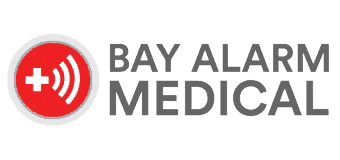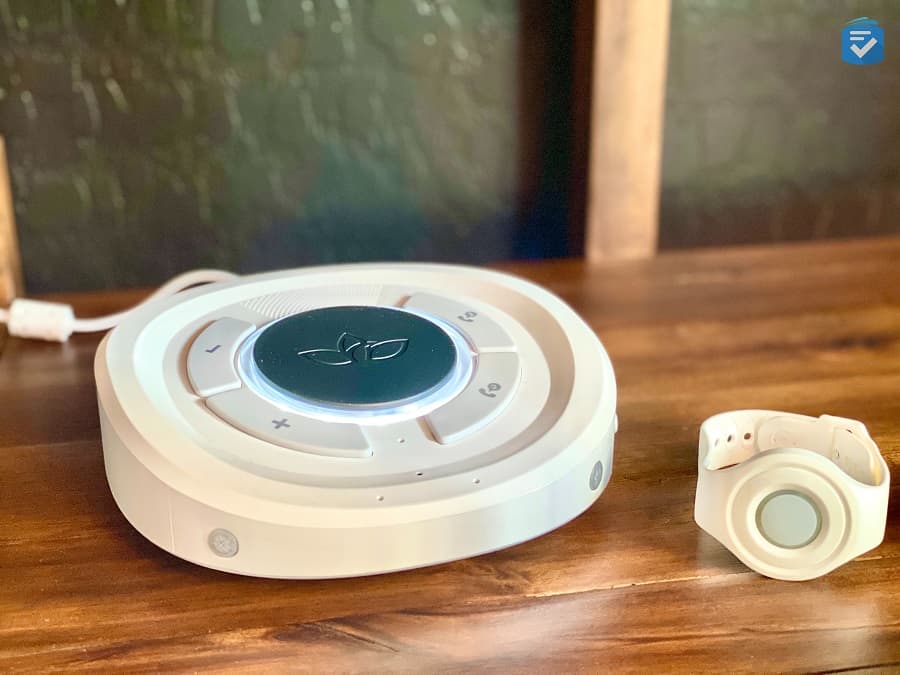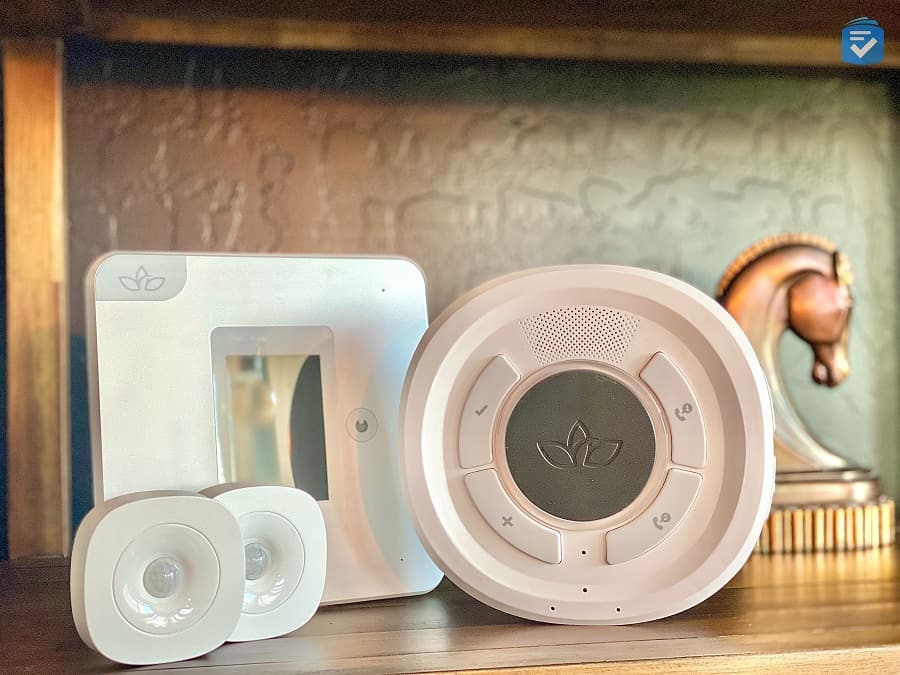
More Favorites From The Senior List
We picked out a few more recommendations worth considering:
CVS Symphony by the Numbers
| Time Spent Testing | 168 Hours |
|---|---|
| Starting Price | $29.99 per month |
| Contract Minimum | 1 Month |
| Average Response Time | 18 Seconds |
| Customer Service Response Time | 12 Seconds |
In early 2021, CVS launched their Symphony line of medical alert systems, a range of devices designed to keep people safe in their homes through the use of innovative fall detection and detailed caregiver tracking. What’s more, these systems are among the few available in stores.
By combining traditional help buttons with a sophisticated range of voice commands, CVS Symphony systems provide a unique means of protection. What’s more, their helpful smartphone app allows caregivers to monitor and communicate with their loved ones from afar.
After thorough testing, here are my main takeaways from using the CVS Symphony Essential Bundle.
Learn More: Looking to learn more about my favorite devices? Check out my pick for this year’s best medical alert system.
Pros and Cons of CVS Symphony Medical Alert Systems
CVS Symphony Pros
- Detailed motion tracking: In contrast to most medical alert devices, the Symphony Essentials package includes two types of motion sensors. A pair of motion sensors can be mounted on the wall, alerting caregivers of any movement or––more importantly––a lack thereof. Additionally, the system’s wall-mounted fall sensor can accurately track falls in the bathroom and alert loved ones accordingly.
- Voice commands: CVS Symphony systems are voice-activated, so no care button is necessary. The entire system can run hands-free. That said, a traditional wristband care button is included for those who want extra peace of mind.
- Helpful caregiver app: The CVS Symphony app, available on both iPhones and Androids, provides your Care Circle, or team of caregivers, a space to check in on you and your living space. For example, when my father opened the app, he found updates on my activity levels, my home temperature, and any commands I used on my smart hub.
- Non-emergency check-ins: While all medical alert systems give users access to professional monitoring centers, CVS Symphony is one of a few providers that allows users to make direct calls to caregivers. Additionally, caregivers can also make direct calls to the Symphony smart hub.
CVS Symphony Cons
- High initial costs: Unlike many companies, CVS Symphony requires you to purchase your equipment rather than lease it with your monthly subscription. On one hand, this means that you own your Symphony equipment; however, this also means you’ll have start-up costs of $150 for the Basic package and $250 for the Essential package. Additionally, monitoring for the Essential package costs $39.99 per month, bringing my total start-up costs to nearly $300.
- No fall detection pendant: While I appreciate that my Symphony Essential system included fall detection at no extra cost, there is no option for wearable fall detection, which might be a drawback for some.
FYI: CVS Symphony systems are made by Aloe Care Health, one of my favorite medical alert providers. Read my Aloe Care Health pricing page to learn more about this company’s systems.
CVS Symphony Systems Overview
- Symphony Basic: CVS Health’s most affordable system, Symphony Basic combines the voice-activated, high-tech monitoring of its smart hub, the collaborative support facilitated by the caregiver mobile app, and your care button to support safety and independence. This system is ideal for those who don’t mind wearing a help button and who don’t require fall detection.
The CVS Symphony Basic bundle includes the smart hub and one help button. - Symphony Essentials: Symphony Essentials comes with all the equipment as the Symphony Basic, including voice-activated access to 24/7 emergency care, a care button, and built-in motion, temperature, and air sensors via the smart hub. A stand-alone smart fall sensor meant for the bathroom, along with two extra motion detectors, allow for even more effective home coverage. The Symphony Essentials Bundle is an ideal package for those living in larger homes who would also like fall detection.
CVS Symphony Medical Alert Features
| Two-Way Talk | Yes |
|---|---|
| Connectivity | Cellular |
| Average Response Time | 21 seconds |
| In-Home Range | 200 feet |
| Fall Detection | Included |
| Caregiver Portal | Yes |
Using My CVS Symphony Medical Alert System
Upon receiving my CVS Symphony Essential Bundle, I opened up my box and found the following:
- 1 voice-activated smart hub
- 1 help button with wristband and pendant attachments
- 2 motion sensors
- 1 wall-mounted fall sensor
- Various instruction and installation manuals
CVS Symphony Installation
Once I had everything out of the package, I found the six-digit activation code on the bottom of my smart hub and entered the link listed in the instructions into my web browser. The link took me to a third-party company, Aloe Care, that CVS partners with to monitor its systems. Here, I typed in the code to activate my system and purchased a month-to-month monitoring subscription. I also entered my medical information requested so my profile would be complete in case of an emergency.
Alternatively, you can activate your Symphony bundle and purchase a monitoring package by calling the company (844-741-0826) with your code. While this process wasn’t too complicated, it did demand more of my time than other systems. This was a result of syncing the various pieces of equipment with my Wi-Fi network and smartphone app.
Next, I needed to decide where to place my smart hub. The instructions recommended I select a sturdy surface near an outlet in the room where I spend the most time. Additionally, the Symphony smart hub has built-in motion sensors, so it’s important to place this piece of equipment in a place where these sensors face the room. Since I have an open plan living room and dining room, I selected the behind-the-couch table directly between the two rooms and the midpoint for my entire house.
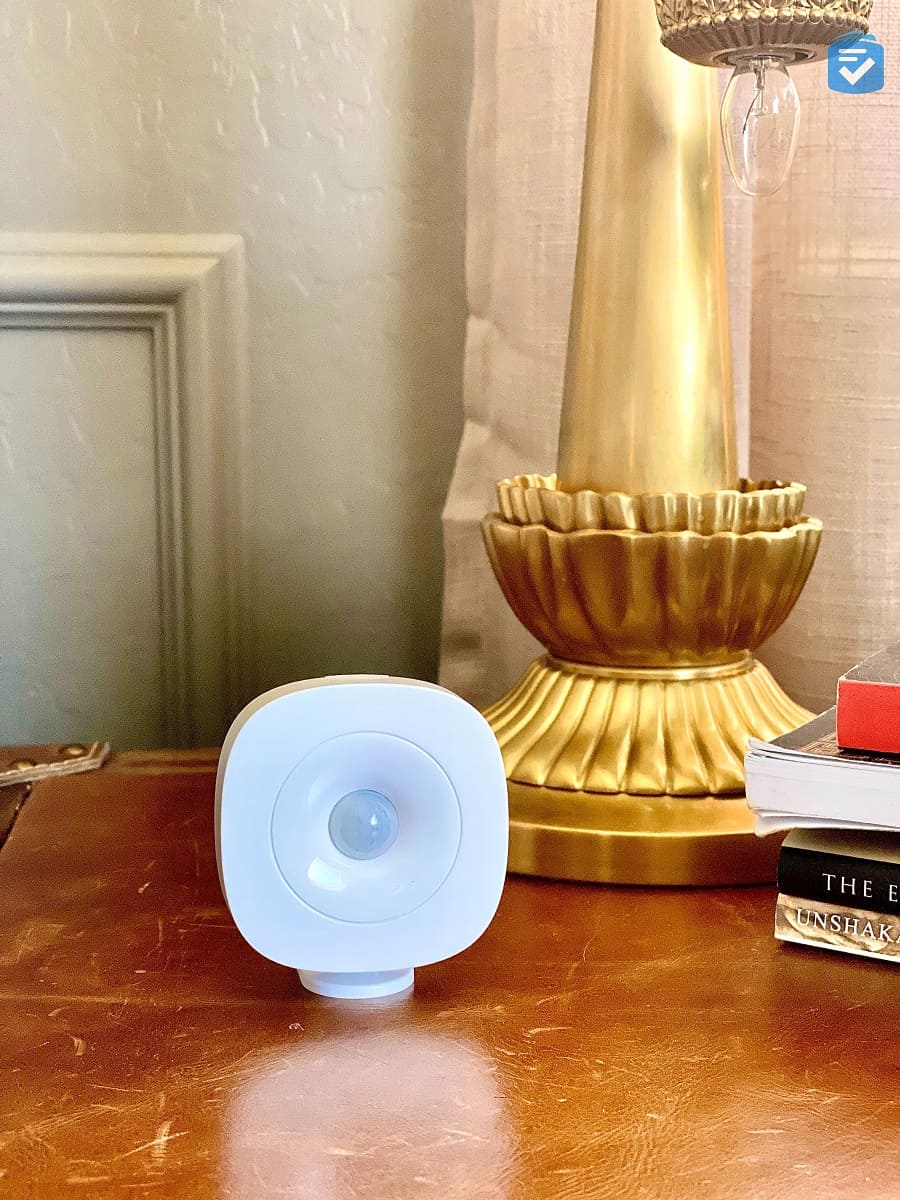
Then, I pressed the black button in the center of the smart hub and followed the voice prompts to finish setting up my system. In-app instructions, which CVS recommends for caregivers setting up a system, are also available on the CVS Health Symphony app. On the whole, installing this system took about 10 minutes, including mounting my motion sensors.
Connection Tip: While Wi-Fi isn’t necessary for CVS Symphony systems to work, you will need to connect if you want to use the fall and motion sensors.
Testing My Symphony Medical Alert System
Getting used to anything new can be a process, so I was relieved when I found out that the CVS Health Symphony app has a learning mode setting. This option allows users, like me, to get familiar with their medical alert and its features without the stress of possibly triggering an emergency call. You can even override it quite easily should an actual emergency arise.
I also used my Symphony app to add my caregivers’ names and information so each of them would receive notifications if I made an emergency call. They can even call you directly using the smart hub. For example, when my father, who I listed as one of my caregivers, received a notification from one of my test calls, he opened the Symphony app and pressed “call.” I accepted his call to my smart hub using a voice command. I enjoyed the ease of these commands and imagine they’re a feature of the Symphony systems that many older adults would find useful following an injury. Alternatively, I could also just press a button on the smart hub to answer his call.
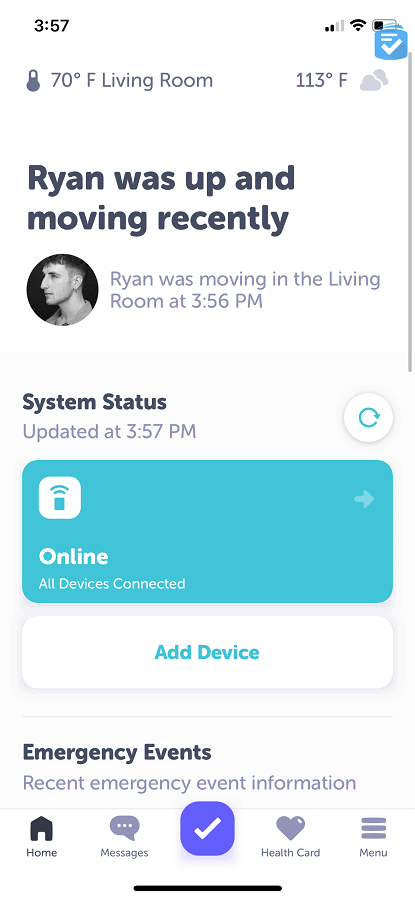
Voice Commands
One of my favorite aspects of this system was its array of voice commands. By simply using my voice, I could:
- Place calls to my caregivers
- Answer calls from caregivers
- Defuse false alarms (ex: cancelling an emergency call from an accidental button push)
- Check my home’s temperature
- Check my device’s status
- Place emergency calls
Response agents consistently answered my calls in less than 30 seconds. In fact, after several test calls, my average wait time was 21 seconds, which is one of the fastest I’ve seen. Additionally, the Symphony response agents were polite, courteous, and patient with me, not to mention their team is UL-listed and TMA 5-Diamond certified.
Although I was a bit nervous about using a medical alert with such an abundance of new technology, I can now confidently say the equipment does its job. I effectively made several calls by activating my care button throughout my home and backyard. I also completed several calls to both the monitoring center and my family by solely using voice commands.
Fall Detection
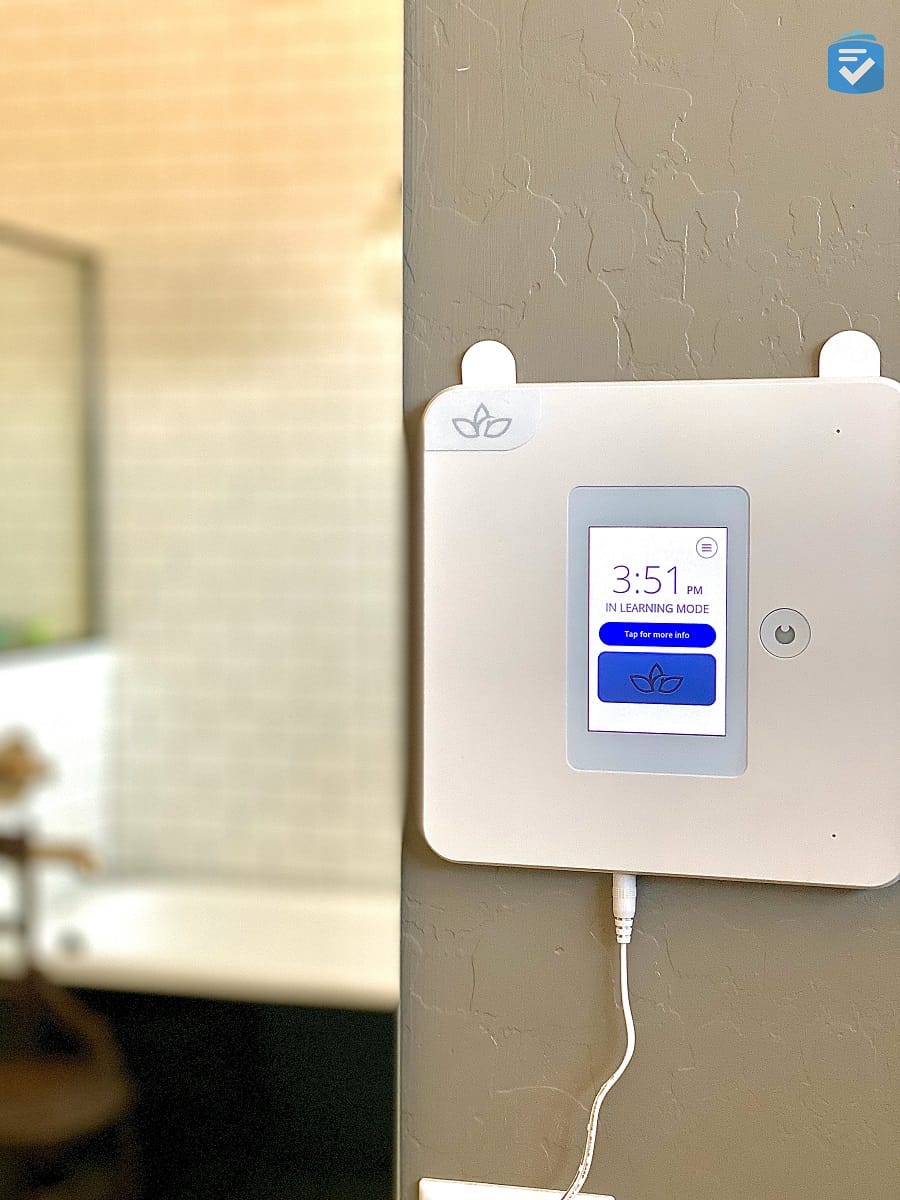
Fall protection in the bathroom is essential. After all, it’s where 80% of older adult falls occur. I put this to the test by laying down on the bathroom floor (on top of a clean towel, of course!) to test the wall-mounted fall sensor. I’ll admit, I was skeptical about where the fall sensor would work, but sure enough, it was able to accurately detect my simulated falls, and it reported no false alarms.
Savings Tip: Symphony products are eligible for health savings accounts (HSA) and flexible spending accounts (FSA). Read my medical alert guide to learn more about ways to offset the costs of these systems.
CVS Symphony Medical Alert Pricing
Symphony Basic costs $149.99 in initial equipment fees and $29.99 for monitoring each month. Slightly more expensive, the Essentials Bundle is $249.99 for its equipment and $39.99 in monthly subscription fees. Although the equipment fees are steep, and monitoring fees aren’t cheap, I think it’s important to note that both Symphony systems feature some of the latest innovations in medical alert technology, an investment many people are willing to pay more for.
CVS Symphony Spouse Monitoring
Aloe Care Health provides additional monitoring for free for spouses or partners who live together. However, if couples choose this setup, CVS recommends purchasing another care button for the second individual for a one-time fee of $29.99.
Final Thoughts on CVS Symphony Medical Alerts
Despite my initial anxiety about a medical alert system packed with so much new technology, I grew to appreciate and trust my Symphony Essential system, especially its motion sensors and range of voice commands. I did pay a bit more for the equipment than I would have liked, but the monitoring fee seemed reasonable for the high-tech services I received. Plus, as a caregiver, I found the Symphony app to be an exceptional tool.
For those familiar with this website, you might have noticed the similarities between the CVS Symphony and Aloe Care Health’s systems. In fact, from the hardware to the app, the devices appear to be identical. Since Aloe Care Health offers systems for a slightly lower price, in addition to their GPS system, I’d recommend looking into Aloe Care Health for a similar system at slightly lower costs. However, CVS’s range of health tools are always evolving, so if you already use the CVS HealthHub, then a Symphony system might be convenient.
Learn More: To learn more about Aloe Care Health, check out my full Aloe Care Health Review.
I’d recommend CVS Symphony if you’re looking for:
- Remote caregiving tools: Symphony Essentials’ caregiver app provides remote caregivers with a more detailed picture of their loved one’s well-being and opportunities to take a more active role in care. Some of these helpful features include alerts about emergency calls or falls, and frequent updates about a loved one’s movement and environment. These include abnormalities in activity patterns, the option to check in through the smart hub, group chat with other caregivers, and more.
- Voice commands: From making emergency calls to checking your home’s temperature, the CVS Symphony is a great voice-activated medical alert.
- An in-store purchase: Most companies sell their medical alert systems online-only, meaning few medical alerts are available on shelves at local brick-and-mortar stores. Still, the option to see an item in real life and physically hold it before making a decision means a lot to some consumers.
- A button-free medical alert: Only a handful of personal emergency response systems function without any type of wearable. CVS Symphony is one of them. If you have struggled to find a medical alert that fits you because of difficulty keeping track of a pendant or your general dislike for emergency care button aesthetics, CVS Health Symphony now offers you a practical option.
I wouldn’t recommend CVS Symphony if you want:
- A highly affordable system: CVS Symphony systems start at $29.99 per month, not to mention steep initial equipment costs. If you want something more affordable, read my guides to cheap medical alerts and unmonitored medical alerts.
- A 30-day, money-back guarantee: Many medical alert brands offer free trials or a 30-day, money-back guarantee. CVS Health’s return policy requires that your Symphony system is in its original packaging, unopened and unused. To learn about one of my favorite companies that offers trial periods, check out my Bay Alarm Medical review.
- Non-stop fall detection: While the Symphony Essentials fall sensor has some pretty neat new technology, it only protects the room you set it up in. Coverage in only one room may not be enough for seniors who exhibit a high tendency toward falls or remote caregivers who want to know their loved one has protection at all times. If you’re looking for a medical alert with continuous fall detection, check out my review of Active Guardian.




